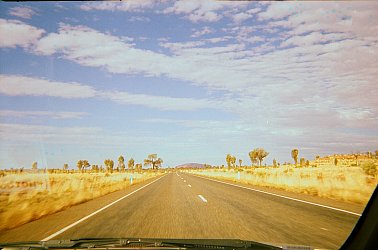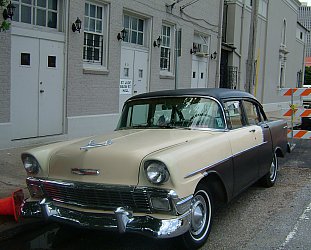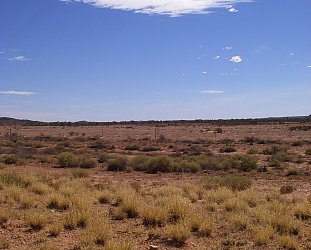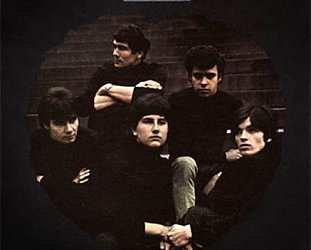Graham Reid | | 6 min read

Eventually curiosity gets the better of me and, on a typically empty stretch of tarseal some 100kms west of Alice Springs, I stop the car and climb a rocky outcrop.
For the past half hour I have had the magnificent MacDonnell Range on my right but 10 minutes ago a strange, irregular wall of bricks ran parallel with the road on my left. I’m puzzled as to who might have built it way out here, so I pull over.
At the top of the hill I get my answer: it is simply a severely linear seam of rock pushed out of this ancient land and running like a wall to the far horizon.
I laugh aloud, it isn’t the first time -- nor the last -- when the landscape beyond Alice Springs, and there is a lot of it, has me bewildered or bemused.
One of the myths about Australian deserts -- yes plural, out here is the interface of the Simpson and Tanami -- is that they are featureless plains of red dust. Nothing could be further from the truth, although the centre certainly offers rust-coloured dirt in abundance.
West of Alice are vast vistas of trees and low lying Spinifex, stony outcrops and tireless sweeps of rolling hills eroded smooth by the ages, the jagged black stone of the mountains . . . and that baffling brick wall.
My day-long drive to Glen Helen, about 140kms from Alice, alongside the West MacDonnell Ranges (which runs seamlessly into the Chewings Ranges and thereafter into the great beyond) is rich in history, and punctuated by picturesque chasms and gorges just off the road.
This was the land of Albert Namatjira, the first Aboriginal artist to gain national attention for painting in a representational style. In the Twenties he lived in this region near Hermannsburg to the south and his watercolours captured the raw beauty of the mountains, billabongs and deep chasms around here.
In recent decades however it has been the distinctive Aboriginal “dot painting” which has called tourists here.
It was at Papunya about three hours west of Alice where the dot art movement began in the early 70s. Since then it has flourished and today galleries and shops in Alice -- population about 30,000 -- are stocked with dot work of variable quality.
If it is dots you are after you won’t be disappointed in Alice: tables in cafes, rubbish receptacles in the mall, t-shirts and street murals are festooned with them -- which diminishes the power of the real thing in the many galleries in town.
“Some of these people would put a dot on you if you stood still for long enough,” says a cynical dealer.
Yet there is no denying the beauty and power of artists such as Dorothy Napangardi whose work has been exhibited in Sydney’s Museum of Modern Art.
The reputable galleries in Alice offer certificates of authenticity and have a responsible social contract with local painters.
“Not every Aboriginal is an artist,” says my dealer friend candidly while noting too many tourists snap up the cheaper stuff while recoiling from the obviously superior if more expensive art.
The world of Aboriginal art is minefield -- as hinted at in the current film Samson and Delilah which is set in and around Alice Springs. As one short, but tragically true scene illustrates, many Aboriginals on compounds are delivered booze, paint, brushes and canvas by unscrupulous “dealers” who then pay a pittance for the finished “art” and on-sell the work to galleries for vastly inflated prices.
The scandal has been exposed by the media and yet reputable dealers will tell you the practice persists.
Samson and Delilah, which unflinching shows alcoholism and the violence of Aboriginal communities as well as being a redemptive love story, puts images on the screen familiar to anyone who has walked the streets of this remote town.
Alice -- which gets by on the myth it is the near Uluru, the big red rock in fact about 400km south-west -- is fascinating. The Telegraph Station outside of town, the Old Ghan Railway Museum and the local cemetery are testament to early European explorers and fortune-seekers who came to this arid place in search of opportunity and mineral wealth -- or maybe even the mythical lake which early cartographers drew on the maps in the belief the centre could not be entirely devoid of water.
Stories of prospectors such as the eccentric and gold-obsessed Harold Lasseter confirm you had to be crazy or hardy to survive here.
The hardy, or foolhardy, can walk the Larapinta Trail which runs from just outside Alice along the spine of the MacDonnells for over 200 kilometres and is divided into 12 separate stages. But an air-conditioned car is my chosen mode to see this remote and spectacular part of the world.
Outside Alice is Simpsons Gap where Red Gums line a white sand riverbed which weaves through a small cut in the mountains, eroded out over some 60 million years. At this popular picnic spot are rare rock wallabies -- although maybe not that rare, half a dozen warily watch about the same number of humans. Otherwise the solitude is breathtaking.
At nearby Standley Chasm I am by myself when making my way to the renown rock walls which I’m told glow like scarlet fire in the midday sun. I am contemplating the silence when up ahead is throng of people with cameras poised. By chance I have arrived at noon and the rocks are about to put on their lunchtime show.
As the sun nudges over a ridge the canyon walls blaze fiery red, the cameras click, and kids whoop with delight while adults make whispered “awww“ sounds.
Spectacular, but I am gone . . . off to Ellery Creek Big Hole which lives up to its name: a large lake, pale brown in the shadows of the cliff or bright blue when it reflects the sky above.
Even more spectacular is Ormiston Gorge and Pound some 40kms further on. The sheer cliffs glow green, red, pink and pale blue in the afternoon sun and, as with that “wall” alongside the highway, seems to be composed of mathematically designed blocks and layers.
I am alone for an hour watching the passage of sun and clouds across the landscape. It is mesmerising.
After dinner at Glen Helen Resort -- my modest but comfortable room facing a towering wall of rock across the riverbed -- I walk into the dusty and dark land and lie down far from the happy chatter of the dining hall. The sky is abright with patterns and possibilities and when a star falls across the infinite void -- white, brief and unexpected -- you could become philosophical about the equally fleeting moment we have in this vastness.
Anyone fearful of their own company, or who need to be attached to cellphones and iPods, might be unwise to spend too much time out here. You are alone with your thoughts.
The unfathomable passage of time is ever-present in mountains which have been here for hundreds of millions of years, and at the Ochre Pits which glow yellow, reddish-brown and white. They line a dry creek and have been used by Aboriginal peoples for . . . in truth, no one can say how long.
Everything out here is on a large scale, whether it be time or distance. The best way to appreciate the scale of the land is to get up high.
At Glen Helen the next morning I climb into a chopper with Peter who takes us high over Ormiston Pound and the range which runs like a backbone across the vast landscape, disappearing into the blue haze of the horizon in each direction, as does the road snaking alongside it. I can see that “brick wall”, the dry river beds, the spotting of Spinifex everywhere . . . The world beneath is dot painting, an endless line of low rolling hills runs parallel to the MacDonnell Range. The Aboriginal people call it Caterpillar Dreaming. That makes sense.
Back in Alice Springs that night I look at the map. Tomorrow I am driving to Kings Canyon through an equally dramatic, beguiling and bewildering landscape of ever-changing desert, mountains and red dust.
It is about 480kms -- and I can’t wait.







mark robinson - Mar 18, 2010
I was 22 years old and 6 months into a back-pack-around-the-world-experience from my home town of Slough in the UK when the bus pulled into Alice Springs late one afternoon. That evening we did beers as you do. The next day the bus picked us up at 7am for the drive to Uluru (actually it was stil known as Ayres Rock back in 1986) and although I had just travelled through India and South East Asia the strength of the sun, at that hour of the day, took my breath away. The bus journey was a long one. I remember being suprised by the distance from Alice to the rock. The bus was not a typical "back-packers" tour bus but an Interstate and so the passengers ranged from a few back-packers to "Oz oldies" on a trip to finally climb the rock. The bus arrived early afternoon and off we went up the rock. To this day I have not experienced such a feeling of utter exhaustion and thirst as i did that afternoon. Alan and I, despite being younger than many of the group were the last to the top. Stunning in so many ways. Alan and I signed the book at the top. I have often wondered where that book is and how I would love to read my comment of 24 years ago.
Savea great article Graham.
post a comment